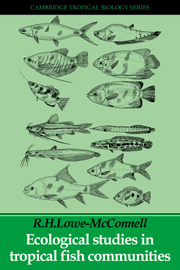Book contents
- Frontmatter
- Contents
- Preface
- Acknowledgements
- PART I INTRODUCTION
- PART II FRESHWATER STUDIES
- 2 The African fish fauna
- 3 Man-made lakes
- 4 Lacustrine fish communities in the Great Lakes of eastern Africa
- 5 Speciation: the African Great Lakes as laboratories of evolution
- 6 The Neotropical fish fauna
- 7 Far Eastern freshwater fish faunas and their distributions
- PART III MARINE FISH STUDIES
- PART IV SYNTHESES
- Appendix: Fish families in tropical waters
- References
- Index
4 - Lacustrine fish communities in the Great Lakes of eastern Africa
Published online by Cambridge University Press: 07 May 2010
- Frontmatter
- Contents
- Preface
- Acknowledgements
- PART I INTRODUCTION
- PART II FRESHWATER STUDIES
- 2 The African fish fauna
- 3 Man-made lakes
- 4 Lacustrine fish communities in the Great Lakes of eastern Africa
- 5 Speciation: the African Great Lakes as laboratories of evolution
- 6 The Neotropical fish fauna
- 7 Far Eastern freshwater fish faunas and their distributions
- PART III MARINE FISH STUDIES
- PART IV SYNTHESES
- Appendix: Fish families in tropical waters
- References
- Index
Summary
We have seen how West African riverine fish communities changed into lacustrine ones in the newly created man–made lakes, also how climatic changes during the 1970s droughts in the Sahelian zone affected fish populations in Lake Chad. How have fish populations responded to the much longer–lasting conditions in the Great Lakes?
Lakes in the Nile drainage with its Nilotic (sudanian) fishes fall into two groups: (1) those with little–modified faunas, showing a low level of endemicity and with few cichlids – Turkana, Albert and Tana; and (2) lakes with a high level of endemism – Victoria, Edward/George – lakes in which cichlids dominate the faunas, as they do in Kivu and Tanganyika in the Zaire drainage and Malawi in the Zambezi drainage (Table 2.2).
Lake Albert (Mobutu) in the western rift valley, a 150 km long, 35 km wide, 56 m deep lake, from which the White Nile flows, has a fish fauna most of which is shared with the Nile. The river has, however, a few species which have not colonized the lake and the lake has a few endemic species: about six endemic cichlid species, one cyprinid species and an offshore–living Lates, L. macrophthalmus, living over the deeper waters.
- Type
- Chapter
- Information
- Ecological Studies in Tropical Fish Communities , pp. 73 - 107Publisher: Cambridge University PressPrint publication year: 1987
- 1
- Cited by



